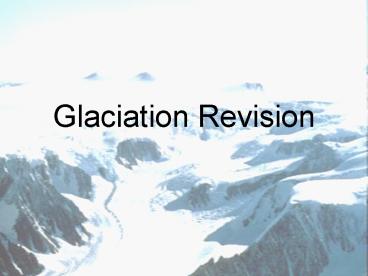Glaciation Revision - PowerPoint PPT Presentation
1 / 19
Title:
Glaciation Revision
Description:
Ar te. Grid Square. Glacial Features. Formation of Glacial ... U-shaped valley truncated spur arete. ribbon lake miss-fit stream. Tarn Pyramidal Peak Corrie ... – PowerPoint PPT presentation
Number of Views:423
Avg rating:3.0/5.0
Title: Glaciation Revision
1
Glaciation Revision
2
What you need to know
- Features of Glacial Erosion
- How the features were formed including diagrams
to show their formation - Land uses in glaciated uplands
- Land use conflicts in glaciated uplands and
solutions to these - KEY WORDS ABRASION, PLUCKING
3
What are the features of glacial erosion?
- U-shaped Valley
- Hanging Valley
- Corrie
- Tarn (Corrie Lochan)
- Pyramidal Peak
- Arete
- Ribbon Lake
- Miss-fit stream
- Truncated Spur
- Scree
4
A very common glaciation question featured in
2001
- a) Using the Torridon map provided, match
each of the glacial features in the table below
to the correct grid square. - Choose from 952588, 923580, 852585, 860601,
925576 (3marks) - THEN
- b) Explain how one of the glacial features
listed in (a) was formed. You may use a sketch to
illustrate your answer.
5
Formation of Glacial Erosion Features
As we have seen, exam questions on Landscapes
of Glacial Erosion often ask for a diagram of how
a particular feature is formed. You should
practice drawing as many of these as you can..
Corrie Arête and Pyramidal Peak U Shaped
Valley Hanging Valley Ribbon Lake
6
How is a U-shaped valley formed?
a) glacier flows in an earlier 'V' shaped valley,
b) glacier abrades the sides and floor of the
river valley, c) valley is greatly deepened,
widened and straightened, d) when the ice melts
the valley is 'U' shaped, e) it has very steep
sides and a fairly flat floor, f) any later
rivers are called 'misfit streams' because they
are far too small to have cut the valley.
7
- Along its journey down the valley a glacier would
be joined by tributary glaciers. - These smaller tributary glaciers contained much
less ice and so were less powerful. - They could not erode their valleys as deeply as
the main glacier so, where they met, the
tributary valley was left hanging above the
main valley.
Formation of a Hanging Valley
8
Formation of a Ribbon Lake
- At some points along the valley the glaciers were
able to erode more deeply than elsewhere through
plucking and abrasion. - Wherever ice did this, it would make a hollow
which, after glaciation, would become a lake. - The lake would then take on the same shape as the
valley in which it was formed, so it would be
long and narrow or ribbon shaped.
9
How is a corrie formed?
a) snow collects in hollows, b) snow compacts to
ice, c) ice moves under gravity, lubricated by
meltwater, d) ice rotates to lip, e) abrasion
deepens corrie, f) plucking steepens back and
sides, g) corrie lochan may fill hollow.
10
How is a Pyramidal Peak formed?
- a) three or more corries form around a peak,
(processes are the same as for corries), b) where
corrie sidewalls meet they form an arête (knife
edge).
11
Land uses in glaciated uplands
- Farming
- Forestry
- Recreational
- Water Sports
- Skiing
- Hydro-electric power
12
Why is forestry good in upland areas?
- Because the land is generally unsuitable for
farming due to poor soils and steep slopes so
forestry would be a more profitable land use. - Trees prevent soil erosion
- The best areas would be on the lower slopes near
the main roads to provide access for transport
and machinery. - The higher mountainous area is less suitable due
to colder growing conditions/poorer soil and the
difficulty of using machinery on steep slopes. - Attracts wildlife
- Benefits to tourism forest walks etc.
13
Farming in Glaciated Uplands
- U-shaped valley - flat or gently sloping land
which could support arable farming - Floodplains - soil is better (fertile)
- Communication systems (transporting goods to
market and allowing workers on the farm access) - Slopes - the main activity would be hill-sheep
farming. - Trees where the sheep can shelter
- On more mountainous land, commercial farming
activity would be limited because of steep land,
poor soils, cold weather and inaccessibility to
markets.
14
What would make an area good for..
- Skiing?
- Good slopes
- Services (shops etc which you would find in a
village) - Communication systems (roads)
- Places to stay (village/town with hotels)
15
Land-use conflicts
- National Parks
- Cairngorms
- skiing
- Loch Lomond and The Trossachs
- Vandalisim
- Littering
- Planning permision
16
Different parties involved in Land Use Conflicts
- National Park Authority
- Environmentalists
- Local People
- Businessmen
- Local Businesses
- Users of the National Park walkers etc
17
Other land uses in Glaciated Uplands
- Quarrying
- Hydro-electric power
- Conflicts?
- Think about
- Environment
- Economy
- Social
- Sustainable Development
18
Glaciation Bingo
- U-shaped valley truncated spur arete
- ribbon lake miss-fit stream
- Tarn Pyramidal Peak Corrie
- Scree Abrasion Plucking glacier
- Hanging Valley National Park Skiing
19
What you need to know
- Features of Glacial Erosion
- How the features were formed including diagrams
to show their formation - Land uses in glaciated uplands
- Land use conflicts in glaciated uplands
- KEY WORDS ABRASION, PLUCKING































